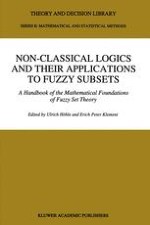1995 | OriginalPaper | Buchkapitel
Commutative, residuated 1—monoids
verfasst von : U. Höhle
Erschienen in: Non-Classical Logics and their Applications to Fuzzy Subsets
Verlag: Springer Netherlands
Enthalten in: Professional Book Archive
Aktivieren Sie unsere intelligente Suche, um passende Fachinhalte oder Patente zu finden.
Wählen Sie Textabschnitte aus um mit Künstlicher Intelligenz passenden Patente zu finden. powered by
Markieren Sie Textabschnitte, um KI-gestützt weitere passende Inhalte zu finden. powered by
The purpose of this paper is to outline a common framework for a diversity of monoidal structures which constitute the basis of various papers in fuzzy set theory. The most frequent structures we encounter in the literature are given by Hey ting algebras, MV-algebras and semigroup structures on the real unit interval (so-called t-norms ([27]). Heyting algebras appear in papers looking from an intuitionistic point of view at fuzzy set theory, MV-algebras form the base for a positivistic approach to fuzzy set theory (cf. Poincaré's paradox and related topics in [15]), and finally t-norms are prefered by statisticians working with a probabilistic understanding of fuzzy set theory. All these monoidal structures have in common the following basic properties : Integrality, commutativity of the semigroup operation * and the existence of a binary operation which is adjoint to the given operation *. Therefore we claim that the structure of integral, commutative, residuated l-monoids forms the appropriate level of generality for our intension.
